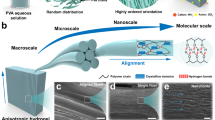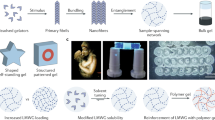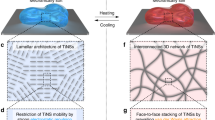Abstract
Hybrid sol–gel materials have been a subject of intensive research during the past decades because these nanocomposites combine the versatility of organic polymers with the superior physical properties of glass. Here, we report the synthesis, by spin coating, of hybrid interpenetrating networks in the form of free-standing nanomembrane (around 35-nm thick) with unprecedented macroscopic size and characteristics. The quasi-2D interpenetration of the organic and inorganic networks brings to these materials a unique combination of properties that are not usually compatible within the same film: macroscopic robustness and homogeneity, nanoscale thickness, mechanical strength, high flexibility and optical transparency. Interestingly, such free-standing nanofilms of macroscopic size can seal large openings, are strong enough to hold amounts of liquid 70,000 times heavier than their own weight, and are flexible enough to reversibly pass through holes 30,000 times smaller than their own size.
This is a preview of subscription content, access via your institution
Access options
Subscribe to this journal
Receive 12 print issues and online access
$259.00 per year
only $21.58 per issue
Buy this article
- Purchase on Springer Link
- Instant access to full article PDF
Prices may be subject to local taxes which are calculated during checkout






Similar content being viewed by others
References
Stroock, A., Kane, R. S., Weck, M., Metallo, S. J. & Whitesides, G. M. Synthesis of free-standing quasi-two-dimensional polymers. Langmuir 19, 2466–2472 (2003).
Jiang, C., Markutsya, S., Pikus, Y. & Tsukruk, V. Freely suspended nanocomposite membranes as highly sensitive sensors. Nature Mater. 3, 721–727 (2004).
O'Connel, P. A. & McKenna, G. B. Rheological measurements of thermoviscoelastic response of ultrathin polymer films. Science 307, 1760–1763 (2005).
Mattsson, J., Forrest, J. A. & Borjesson, L. Quantifying glass transition behaviour in ultrathin free-standing polymer films. Phys. Rev. E 62, 5187–5200 (2000).
Tang, Z., Kotov, N. A., Magonov, S. & Ozturk, B. Nanostructured artificial nacre. Nature Mater. 2, 413–418 (2003).
Mallwitz, F. & Laschewsky, A. Direct access to stable, freestanding polymer membranes by layer-by-layer assembly of polyelectrolytes. Adv. Mater. 17, 1296–1299 (2005).
Mamedov, A. et al. Molecular design of strong single-wall carbon nanotube/polyelectrolyte multiplayer composites. Nature Mater. 1, 190–194 (2002).
Huck, W. T., Stroock, A. D. & Whitesides, G. M. Synthesis of geometrically well-defined, molecularly thin polymer films. Angew. Chem. Int. Edn 39, 1058–1061 (2000).
Mamedov, A. & Kotov, N. Free-standing layer-by-layer assembled films of magnetite nanoparticles. Langmuir 16, 5530–5533 (2000).
Mallwitz, F. & Goedel, W. A. Physically cross-linked ultrathin elastomeric membranes. Angew. Chem. Int. Edn 40, 2645–2647 (2001).
Eck, W., Küller, A., Grunze, M., Völkel, B. & Gölzhäuser, A. Freestanding nanosheets from crosslinked biphenyl self-assembled monolayers. Adv. Mater. 17, 2583–2587 (2005).
Xu, H. & Goedel, W. A. Polymer-silica hybrid monolayers as precursors for ultrathin free-standing porous membranes. Langmuir 18, 2363–2367 (2002).
Nardin, C., Winterhalter, M. & Meier, W. Giant free-standing ABA triblock copolymer membranes. Langmuir 16, 7708–7712 (2000).
Jiang, C., Markutsya, C. & Tsukruk, V. Compliant, robust, and truly nanoscale free-standing multilayer films fabricated using spin-assisted layer-by-layer assembly. Adv. Mater. 16, 157–161 (2004).
Markutsya, S., Jiang, C., Pikus, Y. & Tsukruk, V. Freely suspended layer-by-layer nanomembranes: testing micromechanical properties. Adv. Funct. Mater. 15, 771–780 (2005).
Jiang, C., Markutsya, S., Shulda, H. & Tsukruk, V. Freely suspended gold nanoparticle arrays. Adv. Mater. 17, 1669–1673 (2005).
Ko, H., Jiang, C., Shulda, H. & Tsukruk, V. Carbon nanotube arrays encapsulated into freely suspended flexible films. Chem. Mater. 17, 2490–2493 (2005).
Decher, G. Fuzzy nanoassemblies toward layered polymeric multicomposites. Science 277, 1232–1237 (1997).
Johal, M. S. et al. Polyelectrolyte trilayer combinations using spin-assembly and ionic self-assembly. Langmuir 19, 8876–8881 (2003).
Hashizume, M. & Kunitake, T. Preparation of self-supporting ultrathin films of titania by spin-coating. Langmuir 19, 10172–10178 (2003).
Hashizume, M. & Kunitake, T. Preparation and functionalization of self-supporting (polymer/metal oxide) composite ultrathin films. RIKEN Rev. 38, 36–39 (2001).
Sharp, K. G. Inorganic/organic hybrid materials. Adv. Mater. 10, 1243–1248 (1998).
Matejka, L. & Dukh, O. Organic-inorganic hybrids networks. Macromol. Symp. 171, 181–188 (2001).
Saegusa, T. Organic-inorganic polymers hybrids. Pure Appl. Chem. 67, 1965–1970 (1995).
Imai, Y., Naka, K. & Chujo, Y. Reversible formation of interpenatrating polymer network structure in organic-inorganic polymer hybrids. Polym. J. 30, 990–995 (1998).
Tamaki, R., Naka, K. & Chujo, Y. Synthesis of polystyrene/silica gel polymer hybrids by in situ polymerisation method. Polym. Bull. 39, 303–310 (1997).
Sperling, L. H. & Mishra, V. The current status of interpenetrating polymer networks. Polym. Adv. Technol. 7, 197–208 (1996).
Chang, S. & Doong, R. ZrO2 thin films with controllable morphology and thickness by spin-coated sol-gel method. Thin Solid Films 489, 17–22 (2005).
Polli, A. D. et al. Structural characterisation of ZrO2 thin films produced via self-assembled monolayer-mediated deposition from aqueous dispersions. Thin Solid Films 379, 122–127 (2000).
Sanchez, C. et al. Designed hybrid organic-inorganic nanocomposites from functional nanobuilding blocks. Chem. Mater. 13, 3061–3083 (2001).
Rajan, G. S., Sur, G. S., Mark, J. E., Sharfer, D. W. & Beaucage, G. Preparation and characterisation of some unusually transparent poly(dimethylsiloxane) nanocomposites. J. Polym. Sci. B 41, 1897–1901 (2003).
Sur, G. S. & Mark, J. E. Reinforcing effects from silica-type fillers containing hydrocarbon groups. Polym. Bull. 14, 325–329 (1985).
Mammeri, F., Le Bourhis, E., Rozes, L. & Sanchez, C. Mechanical properties of hybrid organic-inorganic materials. J. Mater. Chem. 15, 3787–3811 (2005).
Sur, G. S. & Mark, J. E. Elastomeric networks cross-linked by silica or titania fillers. Eur. Polym. J. 21, 1051–1052 (1985).
Merkel, T. C. et al. Ultrapermeable, reverse-selective nanocomposite membranes. Science 296, 519–522 (2002).
Kato, D. et al. Permselective monolayer membrane based on two-dimensional cross-linked polysiloxane LB films for hydrogen peroxide detecting glucose sensors. Chem. Commun. 2616–2617 (2002).
Ichinose, I., Mizuki, S., Ohno, S., Shiraishi, H. & Kunitake, T. Preparation of cross-linked films based on layer-by-layer assembly of polymers. Polym. J. 31, 1065–1070 (1999).
Lutkenhaus, J. L., Hrabak, K. D., McEnnis, K. & Hammond, P. T. Elastomeric flexible free-standing hydrogen-bonded nanoscale assemblies. J. Am. Chem. Soc. J. 127, 17228–17234 (2005).
Cho, J., Char, K., Hong, J. D. & Lee, K. B. Fabrication of highly ordered multilayer films using a spin self-assembly method. Adv. Mater. 13, 1076–1078 (2001).
Chiarelli, P. A. et al. Controlled fabrication of polyelectrolyte multilayer thin films using spin-assembly. Adv. Mater. 15, 1167–1171 (2001).
Goedel, W. A. & Heger, R. Elastomeric suspended membranes generated via Langmuir-Blodgett transfer. Langmuir 14, 3470–3474 (1998).
Becker, N. et al. Molecular nanosprings in spider capture-silk threads. Nature Mater. 2, 278–283 (2003).
Gong, J. P., Katsuyama, Y., Kurokawa, T. & Osada, Y. Double networks hydrogels with extremely high mechanical strength. Adv. Mater. 15, 1155–1158 (2003).
Na, Y. H. et al. Structural characteristics of double networks gels with extremely high mechanical strength. Macromolecules 37, 5370–5374 (2004).
Acknowledgements
This work was supported by the postdoctoral program for foreign researchers of the Japan Society for the Promotion of Science (JSPS) through a fellowship awarded to R.V.
Author information
Authors and Affiliations
Corresponding author
Ethics declarations
Competing interests
The authors declare no competing financial interests.
Supplementary information
Supplementary Information
Supplementary movie S1 (WMV 4425 kb)
Supplementary Information
Supplementary movie S2 (WMV 4589 kb)
Supplementary Information
Supplementary movie S3 (WMV 4393 kb)
Supplementary Information
Supplementary movie legends and figures S1, S2, S3 (PDF 1120 kb)
Rights and permissions
About this article
Cite this article
Vendamme, R., Onoue, SY., Nakao, A. et al. Robust free-standing nanomembranes of organic/inorganic interpenetrating networks. Nature Mater 5, 494–501 (2006). https://doi.org/10.1038/nmat1655
Received:
Accepted:
Published:
Issue Date:
DOI: https://doi.org/10.1038/nmat1655
This article is cited by
-
Nanocellulose-Graphene Hybrids: Advanced Functional Materials as Multifunctional Sensing Platform
Nano-Micro Letters (2021)
-
On the injectability of free-standing magnetic nanofilms
Biomedical Microdevices (2017)
-
Development of free-standing polymer nanosheets for advanced medical and health-care applications
Polymer Journal (2016)
-
A new method to invert top-gate organic field-effect transistors for Kelvin probe investigations
Applied Physics A (2013)
-
Preparation and properties of hollow silica tubes/cyanate ester hybrids for high-frequency copper-clad laminates
Journal of Materials Science (2011)



